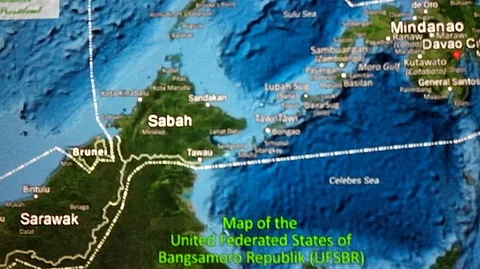
- NEWS
- the EDIT
- COMMENTARY
- BUSINESS
- LIFE
- SHOW
- ACTION
- GLOBAL GOALS
- SNAPS
- DYARYO TIRADA
- MORE

The convernor of the Mindanao Sulu Unification Movement(MSUM) declared on Friday that the assertion of the Two Landmark Laws on the territorial integrity and rights over the all Maritime Zone including the the West Philippine Sea has counter to the the 1915 Carpenter Kiram Treaty signed by the United States and the sultanate of Sulu.
Abraham Idjirani, MSUM convener and secretary-general of the Sultanate of Sulu, told the DAILY TRIBUNE that these laws, primarily authored by re-electionist Senator Francis Tolentino, infringe on the historical rights of the Sultanate of Sulu, or the Bangsa Suluk Nation.
He said the Sultan of Sulu has expressed his strong position regarding the territorial jurisdiction outlined in the 12 June 1898, Philippine Declaration of Independence in Kawit, Cavite, which only covered Luzon and Visayas. At that time, the Sultanate of Sulu—or the Bangsa Suluk Nation—was still exercising its independent sovereignty over its territories, including the Sibutu Sea and the Sulu Sea, as recognized under maritime law.
"The change of the political definition of the territorial integrity and rights now reckoned as the Two Landmark Laws of the Philippines can be disputed by the 1915 Kiram-Carpenter signed by the United States and the Sultanate of Sulu or the Bangsa Suluk Nation," he said.
Idjirani was responding to Senator Tolentino’s statement that the recent laws, which expand sovereign rights and establish sea lanes for both local and foreign vessels and aircraft within Philippine territory, will “take some time” to be fully implemented.
During the Alyansa Para sa Bagong Pilipinas pre-rally press conference, Tolentino mentioned that the Philippine Maritime Zone Law would be submitted to the United Nations in June.
Meanwhile, the Archipelagic Sea Lanes Law requires approval from the International Maritime Organization (IMO) in London.
Tolentino added that Philippine Ambassador to the United Kingdom Teodoro Locsin is closely monitoring the law’s progress with the IMO.
“[Ambassador] Teddy Boy Locsin is focused on IMO’s session every quarter so we are still waiting for the response if anyone will oppose it because it happened in Indonesia before, Australia [also] opposed it that's why the Sea Lanes Law took so long. So what I'm saying is that this is not automatic, that when we approve it, it will be implemented,” Tolentino explained.
Tolentino emphasized that once the IMO approves the Archipelagic Sea Lanes Act, it will strengthen the Philippines’ position in defending its sovereignty.
However, Idjirani argued that the Sultanate of Sulu and the Bangsa Suluk Nation were not incorporated into the Philippines through the 12 June 1898 Philippine Independence Declaration, the 1898 Treaty of Paris, or the 7 November 1900, Cession of Sulu and its underlying islands—including Cagayan de Sulu (now Mapun municipality) and Sibutu Island. Spain, the signatory to the Treaty of Paris and the 1900 cession, did not include these areas in the transaction.
Idjirani pointed out that the Philippines’ claim to these maritime territories under the new laws is instead based on the 1915 Carpenter-Kiram Agreement, which was signed during the American occupation.
According to Idjirani, this agreement granted the United States sovereign power over these territories, which were later incorporated into the Philippines in 1935. The transition was formalized after the 10-year period outlined in the 1934 Tydings-McDuffie Law, leading to the full integration of these areas into Philippine territory when the Third Republic of the Philippines gained independence on 4 July 1946.
He also cited a provision from the Carpenter-Kiram Treaty of 1915.
He said the Carpenter-Kiram Treaty of 1915 "assured the Sultan of Sulu and North Borneo full protection should the question of North Borneo (Sabah) arise in the future between him and any foreign authority. Furthermore, the United States promised and committed itself to placing the Sultanate of Sulu and North Borneo, or the Bangsa Suluk Nation, under its protectorate and flag."
"Up to this day, the United States has not acted upon a Congressional Act to abrogate the 1915 Carpenter Kiram agreement. The United States is morally bound and legally obligated to rectify the historical wrongdoing it brought upon the Sultanate of Sulu, and North, or the Bangsa Suluk Nation, and the Bangsa Suluk people." Idjirani said.
Tolentino, for his part, noted that under the new maritime laws, the Philippines will be able to collaborate with allies such as Japan for maritime research.
“For example, [Japan and the Philippines] conducted maritime research on an island, for example, Lawa Island, which is now full of birds. So, they can conduct marine research for three years for instance, which China cannot oppose because it is in international law,” Tolentino said.
Tolentino is one of the authors of Republic Act No. 12064, or the Philippine Maritime Zones Act.
